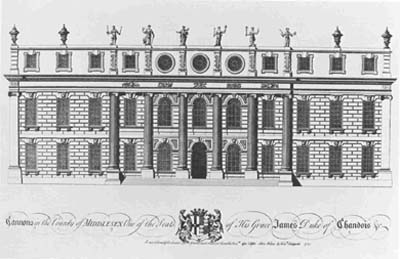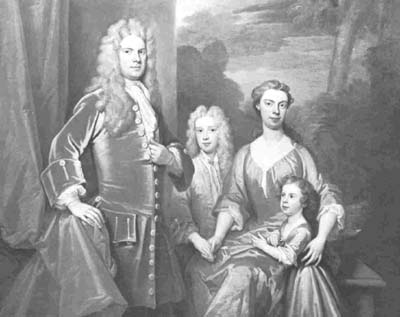
Bulletin 17, 1971
Home
Français
Introduction
History
Annual Index
Author &
Subject
Credits
Contact


Chandos,
Marlborough and Kneller:
Painting and "Protest" in the Age of Queen Anne
by Douglas Stewart
Résumé en français
Pages 1 | 2
| 3 | 4
What is perhaps Sir
Godfrey Kneller's largest work on the North American continent is in
the collection of the National Gallery of Canada - a life-size group
portrait of James Brydges, Ist Duke of Chandos (1674-1744), and his
family (fig. 2). (1) Chandos was one of the most remarkable figures
of his age. The son of a Herefordshire squire, he rose by force of
personality, administrative ability and the favour of the Duke of
Marlborough to become Paymaster of the Forces Abroad during the War
of the Spanish Succession. From this post he amassed an immense
fortune (since the Paymaster was able to speculate with the monies
he received) became a lavish patron of the arts, and in 1719
acquired a dukedom. He remodelled a great Jacobean mansion, Cannons
Park (fig. I), in the Georgian baroque style, stuffed it with works
of art, and kept a "concert" of thirty performers,
eventually including Handel, who wrote his oratorio Esther there. (2)
In certain respects the life-style of "Princely Chandos"
was, as contemporaries recognized, as grand as that of a German
electoral prince, and his ostentation and pretensions were widely
(but wrongly) assumed to be the subject of Pope's satire, "Timon's
Villa", in his Epistle to Lord Burlington. However the
glories of Cannons barely survived its creator's death in 1744, and
within the next four years the whole structure was sold piecemeal
and demolished. Today the only architectural relics are the great
staircase, which after a chequered history has found its way to the
Metropolitan Museum, and the moulded ceiling of the church at Great
Witley, Worcestershire, probably made in papier mâché from
squeezes taken from the stucco work of Bagutti in the Cannons
Chapel. (3)
Some of the contents of Cannons were evidently second-rate works
with lofty attributions. For as Chandos' biographer, C. H. Collins
Baker, observed of him, "his very nature was incurably credulous
and prone to think the best of people: a handicap not altogether
unendearing, but of no positive advantage in collecting
masterpieces." (4) Nevertheless, among Cannons's treasures were
decorations by Laguere, Thornhill and others - Grinling Gibbons'
famous carving of the Stoning of St. Stephen (now in the
Victoria and Albert Museum) and the splendid Poussin, The Choice
of Hercules, now at Stourhead. (5)
Kneller's portrait, which is signed and dated 1713, (6) shows the
Chandos family in Arcadian fashion, on a terrace flanked by curtains
at the left and a landscape with a brook at the right. The picture
now measures 58 by 70 3/4 inches but originally must have been
somewhat larger, judging from a studio copy among the Byng sketch
books in the British Museum (fig. 3). (7) At some point it was cut
down, unfortunately mutilating parts of the work, among them the
small singing bird at the top right.
Over the years, the identity of the sitters (aside from the Duke)
has become confused. George Vertue, the engraver and antiquary,
seems to have begun the process when he visited Cannons in 1725
and recorded "his own picture [i.e. Chandos] his first Lady.
his sons & a daughter by sr. G. Kneller." (8) The entry in the
National Gallery catalogue describes the seated woman as Mary
Lake, Chandos' first wife, and the children as a boy and a girl.
Actually, the woman is Chandos' second wife, Cassandra Willoughby,
whom he married in August 1713, his first wife having died in
December 1712. The children are those of the first wife and are both
boys - (John later Marquis of Camarvon) and Henry (later 2nd Duke of
Çhandos),
aged ten and five years respectively. The misidentification of Henry
as a little girl is not surprising since it was customary in the
seventeenth and eighteenth centuries to dress little boys in
"feminine" robes, usually up to the age of four or five,
when they were "breeched". (9)
The general character of Kneller's picture is uncompromisingly
English Augustan - as plain, sturdy and dignified as a piece of
Addison's prose, or the silver or baluster glasses that graced the
walnut tables of the period. (Quite the opposite of the style across the Channel).
Just two years earlier, Addison himself bad
described French portraits as "very remarkable for their smiles
and a certain smirking Air...bestowed indifferently on every Age
and Degree of either sex. The Toujours Gai appeared even in
Judges, Bishops and Privy Counsellors...every part of the Dress was
in a Flutter, and endeavoured to distinguish itself above the
rest." (10) It was a character that fitted the Duke and his family
admirably since, as Collins Baker has so aptly observed, "James
Brydges was the offspring of a union between the aristocratic
landed gentry and the merchant class, and remained constant to
that parentage. He was not at all our conception of a great
eighteenth-century English duke." (11)
Indeed, in spite of the scale of the portrait, it has a rather
informal, almost domestic air about it, pointing ahead to the
vogue for the "conversation piece". To be sure, the Duke's
pose is conventional enough, and was used by Kneller on at least one
other occasion about this time, (12) but his head is splendidly modelled and is superbly framed by his wig. Moreover, there are
passages of real charm in expression and colour. There is an
appealing homeliness about the Duchess and a touching tenderness in
her relationship with the children, so recently left motherless. The
softness of the central boy' s glance is matched by a softness of
lighting and a transparency of colour and texture, indications of
Kneller's move to a more rococo-like style. (13) They boy wears a faded
rose tunic with blue ties, which serves as both a colouristic and a
compositional caesura. The Duke's coat of cool blue-grey, with
silver buttons and trim, is set off to the left by a bright-red
curtain, and becomes lavender by his son's coat; while the Duchess'
gold dress ripens to orange in the same direction. All these colours
are echoed in the landscape, which like many of Kneller's late
landscapes has a softness and lyricism that seems to look ahead to
Gainsborough.
As we know from the Cannons inventory of 1725, (14) the Kneller group
hung, appropriately enough, in the so-called "Family
Room", presumably over the mantel. (15) Chandos was in fact a
considerable patron of Kneller over the years, as the inventories of
Cannons and the Duke's other houses testify; and apparently only
death prevented Kneller from undertaking the decoration of the Great
Staircase Hall at Cannons. (16)
One of the most interesting of the other Kneller canvases once
owned by Chandos is a signed and dated (1712) full-length portrait
of Chandos' patron, the Duke of Marlborough, which now belongs to
Lord Spencer (fig. 4). (17) The Duke is portrayed in parade armour,
with a curtain and plinth to the left, an eagle above, and in the
background a curious seated female figure with her head resting on
her hand. The meaning of this figure, like that of most of the grisaille
figures in the backgrounds of Kneller's portraits, would
probably have remained obscure but for the happy, chance survival of
explanatory documents.
Next Page | 2
January 1712
1 | 2
| 3 | 4
Annual Index | Author & Subject | Credits | Contact
This digital collection
was produced under contract to Canada's Digital Collections program,
Industry Canada.
"Digital
Collections Program, Copyright
© National Gallery of
Canada 2001"